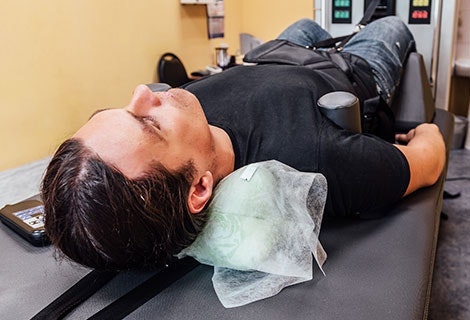Spinal Decompression

NON-SURGICAL SOLUTION TO BACK PAIN
Spinal Decompression can offer a healing relief from back pain. You may want to know whether spinal decompression is the right treatment for you. If your back pain is due to sciatica, herniated disc, bulging disc, slipped disc, pinched nerve, arthritis, lumbar disorders, or chronic back pain; the answer is yes. You are probably an ideal candidate for spinal decompression. If you are suffering from pains due to causes discussed above and prefer to find a non-surgical solution to relief and heal your back pain, spinal decompression is the best solution. Spinal decompression has healed and changed lives of many patients who had given up finding a no risk and effective treatment.
How Spinal Decompression Works
An experimental study has shown than in non-degenerated, but bulging discs (something your MRI or CT scan would show), decompression can lower the pressure inside the disc. This negative pressure may then draw or suck the displaced disc material more towards the center of the disc and away from your nerves. For many patients this can mean pain relief because a compressed nerve is a painful nerve. If the pressure on the nerve is released, it can begin to heal. Spinal Decompression is designed to assist the body’s natural tendency to heal itself because Mother Nature sometimes needs a little help. If the disc can be moved even a small amount away from the nerve, this can be enough to decrease inflammation and irritation. We need more studies to fully understand why patients can improve when they receive this type of treatment and which types of disc problems respond the most.
Spinal Disc Conditions
Thoracic Disc Herniation
Due to the limited motion in the thoracic spine caused by the bony barrier of the ribs, thoracic disc herniations are relatively rare. However, when they do occur, they can create much pain and dysfunction.
The surgical access to the thoracic disc is more complicated than other parts of the spine and may involve the removal of a rib to access an injured disc. This is a complicated surgery that can lead to other unintended consequences. Whenever practical and safe, conservative (nonsurgical) care, such as chiropractic, is advisable prior to the use of more invasive procedures, such as spinal injections or surgery.
